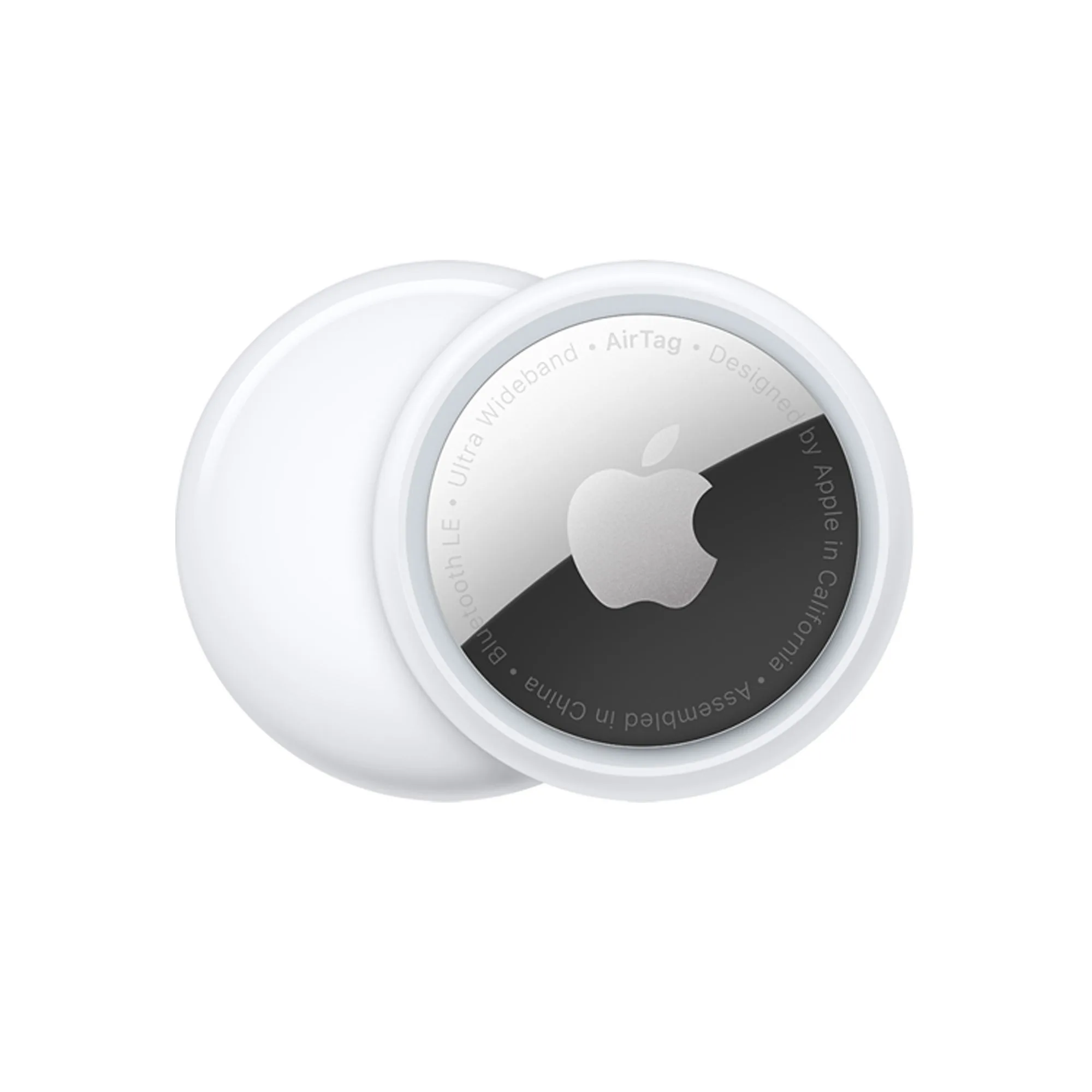Apple AirTag Review: Apple’s Version 1 Tile can’t quite find everything
Summary
Quick verdict: Apple has some immense advantages for ease of setup and wide finding network for its AirTag products, but design miscues and slightly sloppy finding make it a less-than-stellar finding product.
- Stylish design
- Setup and pairing is ridiculously easy
- Privacy features baked in
- Easily replaceable battery
- Find My network has plenty of scale
- Lacks included loop or other fastener
- Battery might be a safety risk
- iPhone only
- Not always great at actually finding lost things
Apple's latest product isn't a fancy new iPhone, iPad or Mac computer. Instead, it's a small disc-shaped object with the Apple logo on one side. It's not a fancy Apple mint, nor is it a hockey puck for rodent-based ice hockey teams.
Instead, it's the Apple AirTag, Apple's take on a Bluetooth tracking module made most famous to date by makers such as Tile.
Apple's got some big advantages over other players when it comes to pairing and to a certain extent with actual AirTag discovery as well, thanks to its existing "Find My" network.
However, it's far from a flawless device in either design or discovery terms. It feels very much like the "version 1" of a product, and it's therefore important to understand what AirTag can and cannot do in the real world beyond the marketing hype.
Design
Design
- Slick Apple design stands out
- Optional engraving
- Lacks any kind of loop or holder
- Easy to remove battery (possibly too easy)
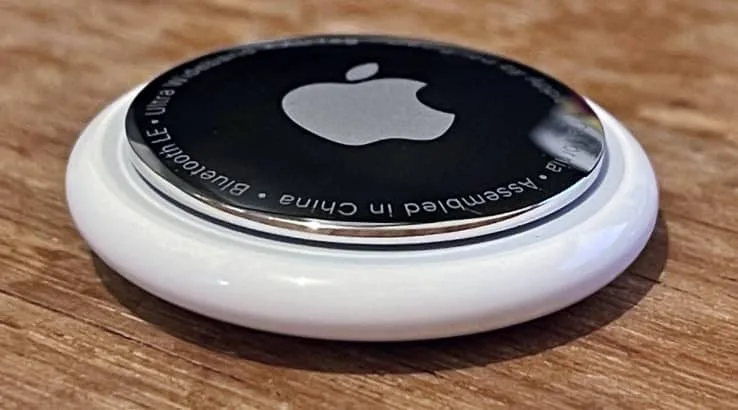
Apple sells AirTag – for whatever reason, it insists the plural of AirTag is "AirTag" as either a single tracker or in packs of four, but whichever you opt for, the actual AirTag tracker is a fairly plain device.
One side houses a metallic back with an Apple logo on it, while the other side is a stark white plastic disc that you can opt to have engraved if you order AirTag through Apple.
That's it, and while the design does feel like it fits well within Apple's design language, it left me wanting just a little more. There's not too much that will make the AirTag stand out beyond that white colour. Having some kind of differentiated colour choices would have helped here.
In terms of size, the best way to describe the AirTag is as a disc about the size and shape of a stack of three Australian 20c pieces. Like this:
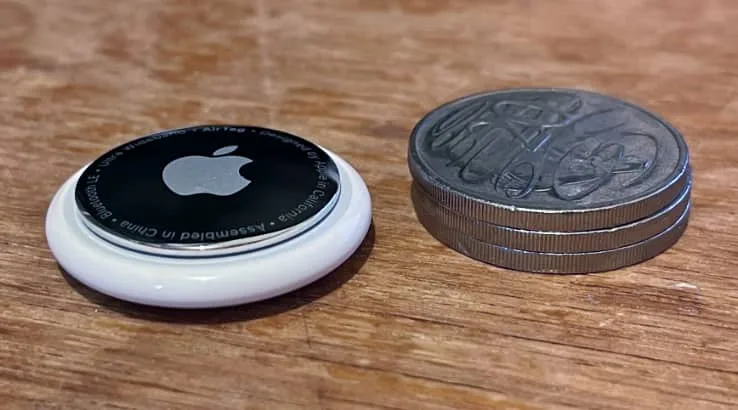
AirTag also lacks any kind of attachment loop or hole, and this is a far more pressing issue for a device that's meant to help you find lost items, because it might just be nice to be able to attach them in some way. Naturally, Apple does sell attachment loops and keyrings. You can even go nuts and spend a lot on some fancy leather Hermes models if you really must.
However, you really shouldn't have to. A four-pack of AirTag devices is about the same price as a cheap Android phone, and they can all afford to throw simple cheap plastic phone cases in their boxes these days, so why can't Apple?
It would have added mere cents to the price of the AirTag, or maybe a dollar to the total consumer price, but instantly made them massively more useful without additional expenditure. Apple supplied me with some of its own brand key chain and loop fixtures for review, but you won't get them unless you give Apple even more money on top of the AirTag price.
The metal feel of the Apple logo side of the AirTag might make you think that this is the brains of the operation, but it's actually the reverse, as this is just a battery cover. On the plus side, you don't have to plug in AirTag to a Lightning cable to charge, and they don't just die once their batteries are exhausted.
Instead, a simple twist of that metal cover releases it, allowing you access to the CR2032 battery that powers the AirTag. Apple says it should be good for up to a year's usage, although understandably I haven't had one secretly for a year to actually test out that claim.
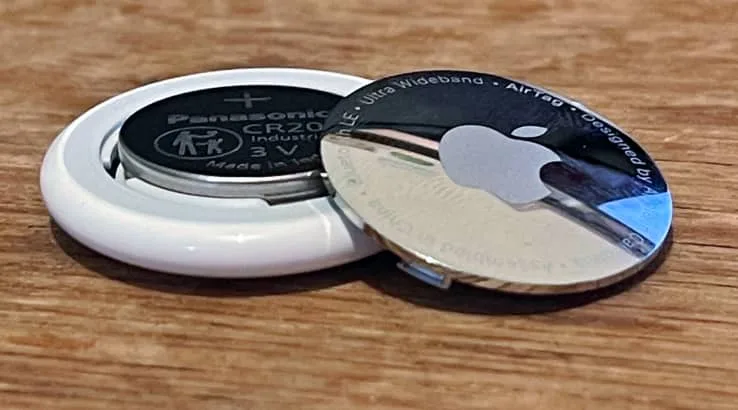
The use of a standard and easily replaceable battery is an admirable design step in one sense, because it gives the AirTag scope for a long service life.
However, there's also a very obvious risk here, because it's not that hard to pop the back cover of an AirTag off. The fatality figures for infants swallowing button cell batteries are genuinely saddening in Australia and elsewhere, and it would be a bad idea to let small children anywhere near an AirTag as a result.
Performance
Performance
- Installation couldn't be easier
- iPhone only
- Directional tracking is neat when it works
- Find My can give rough location, but it's often too rough
- Sound alerts don't always fire up
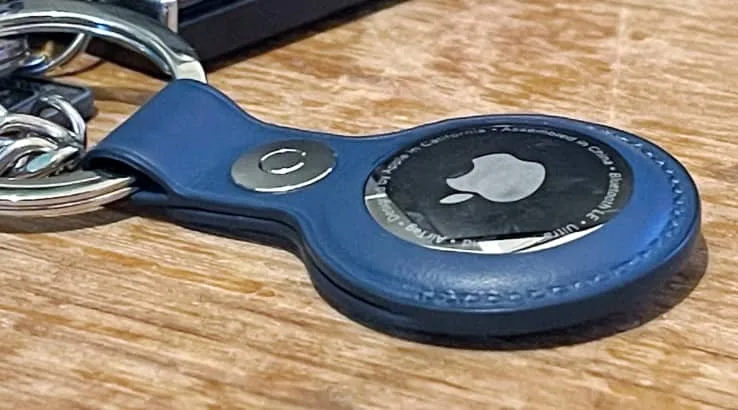
If you've set up a pair of AirPods Max or AirPods Pro on an iPhone before, you'll find the setup process very familiar indeed. Each AirTag comes wrapped in plastic, and the final part of removing that plastic pulls out a divider in the AirTag that finishes its battery contact, springing it to life.
If you've got an iOS or iPadOS device handy running iOS 14.5 or later, the AirTag should pop up on your device's screen mere seconds later. Choose a name for it from the provided list of obvious choices such as keys, camera, handbag and so on, or a custom name if you prefer, and seconds later you're done.
It's a huge benefit for Apple and its AirTags, and considerably simpler than competing solutions that require additional apps and specific Bluetooth pairing. Apple is still using Bluetooth LE for communications, but its control over the entire hardware and software experience gives it an ease of use edge that its competitors cannot match.
That being said, you are stuck with only using iPhones, iPads or iPod Touch devices to register each AirTag. You can't do so on any other phone, and the essential tracking ability is likewise iPhone only for practical purposes. You can't even register an AirTag via a Mac.
Once your AirTag is set up, it basically sits seemingly doing nothing at all. It's not making you a cup of coffee, or going out and finding that lost remote control or anything.
Instead, it acts as a small Bluetooth LE beacon, basically telling the existing Apple Find My network that it exists at a specific location.
That's the whole point of an AirTag, because the idea is that you attach it to or leave it on or in a device that you're concerned about losing.
That makes testing it a matter of deliberately – but rather falsely, let's face it – losing a few key items and seeing just how well AirTags might work at helping me find them.
I started out small, "losing" my keys with an AirTag sitting in an Apple Leather Key Ring (supplied for review) attached on my sofa. Moving a few rooms away, I fired up Find My and asked it to located my keys.
One neat trick here is that if you're using an iPhone 11 or iPhone 12, then it can detect the U1 chip within the AirTag for what Apple calls Precision Finding. This doesn't just (in theory) give you a search area, but instead a directional arrow to follow for close-by AirTag devices to locate them.
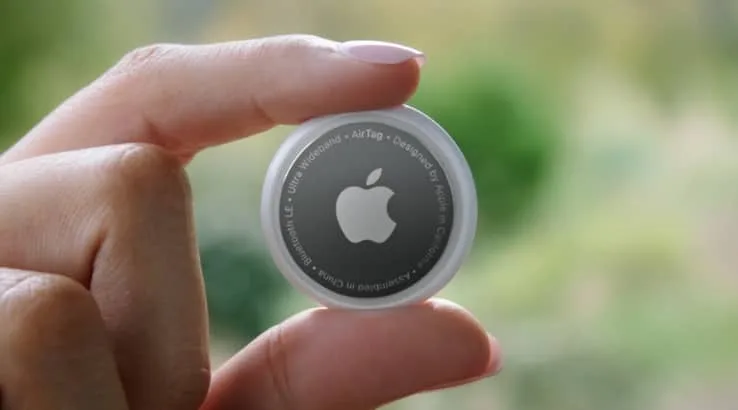
Apple might call it Precision Finding, but in my own tests it was rather hit and miss. I was certainly aware that my keys were in my house, and I'm not expecting (or wanting) Apple to have an internal map of my own home for location purposes.
Depending on my approach angle, Precision Finding either got it dead on, or simply told me I had my keys when I was a metre or more away.
In theory, I could then fire up the speaker in the AirTag to play a sound to help me find them, and locally that did work, but then that kind of noise-location tech is nothing new, and not entirely worth $45 on its own.
It was time to up my game in terms of losing something of value, so I decided I'd lose my car.
Sure, I'm a tech journalist, and it's not as though I'm driving a Tesla just yet, but the experience of losing your car in a big parking lot isn't that uncommon. I left an AirTag in my glovebox at my local supermarket and went and did some shopping before deliberately "forgetting" where I'd parked my car.
I deliberately hadn't fired up "Find My" before I'd decided to "forget" where it was, because you wouldn't likely do so for any item you'd want to keep, would you?
The Find My network relies on having another Find My registered device – most likely an iPhone in any public setting – having detected your AirTag at some recent point in time. You can set AirTags to "lost" mode, at which point the Find My network will alert you if your AirTag is seen for longer term lost items as well.
The Find My network located the rough area where my car was parked, and then sent me on my walking way via Apple Maps. It did so via street directions, which was fair enough given that Apple Maps doesn't have a lot of interior shopping centre detail in Australia as yet.
Still, it didn't do all that well in terms of directing me to anywhere particularly near my car, declaring it was nearby when I was in fact in a distinctly different car park area. I couldn't even see my car from where I was.
It's possible that the AirTag might work a little better if left directly on the dashboard of a car, but that's a bad idea on two levels.
Firstly, in the heat of an Australian summer they're likely to melt into the dash rather permanently, or malfunction. Also, at $45 they're not exactly cheap, and I'd worry about someone deciding to steal a rather obviously Apple-branded product on a whim.
Keeping with the car motif, I enlisted the help of a relative to test whether the AirTags could be used for more on-the-go tracking, leaving an AirTag on their car keys while they drove across Sydney.
I could very roughly see where they had been, but based on phone conversations (over a legal Bluetooth speaker connection) it was very clear that the Find My network is not particularly quick at updating, often lagging many minutes behind the car's actual location. In some ways that's good from a privacy and creepy stalking sense, but equally it makes AirTag a poor solution for, say, finding a lost pet or other moving item. To make matters worse, I couldn't get the lost sound to play on the AirTag at all.
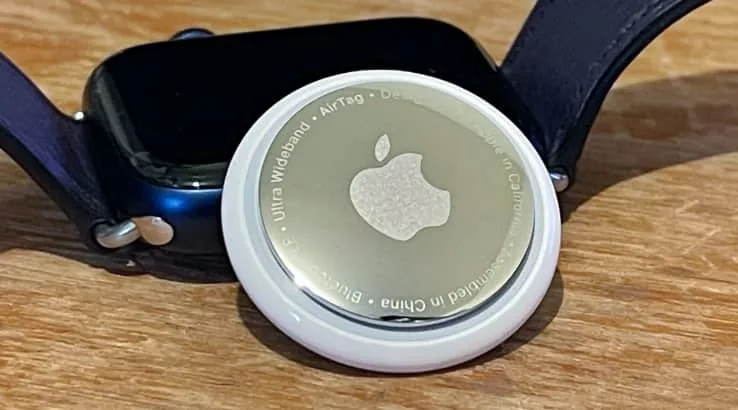
It also highlights another limitation driven by privacy concerns, because even if you explicitly want to and make it clear, you can't actually share an AirTag's location with anyone else.
Yes, that's a big privacy plus to stop abuse of tracking technology, but it also means that you cannot let someone else find you or your AirTag devices even if you both want that to happen, unless you're on the exact same Apple ID on your devices.
Finally, it was time to up the ante and lose something really expensive.
Specifically, I decided to lose my house.
OK, you can't "lose" a house just like that, but I was determined to try, or at least to get AirTag to locate itself within a house that I wasn't in.
Leaving my key tag behind in my home – just like you might leave an item behind somewhere, or indeed have it stolen from you – I walked 2.5km away before engaging the Find My network. That meant that while Find My registered devices in my home should see the AirTag, my phone would be relying on mobile networks until I got within range of my home Wi-Fi.
The Find My network did indeed locate roughly where the AirTag was, and it gave me directions to get to it that were roughly adequate from a distance. I hadn't actually "lost" my house to speak of, so I set to walking and tracking via Apple's directions, which were roughly good up until about the last 50 metres.
That's where I'd hoped that the Bluetooth side of the connection would take over, because Precision Finding should kick in. However, it didn't, instead telling me that the tag was nearby when I was in fact in front of the house next to mine!
My neighbours do subjectively have a nicer house than mine, but I don't think they're going to move out just because Apple says my AirTag is in there – which of course it wasn't.
Find My works off Apple Maps for that kind of finding, so I tried again, walking closer to where I knew it was without trespassing, only to be told that I'd need to move around because it couldn't quite locate the AirTag I wanted it to find.
This continued along my garden path, and all the way to my front door. It couldn't find the AirTag until I opened the front door, at which point the key tag sitting right behind the door was, literally, right in front of me.
Should you buy the Apple AirTag?
- Buy it if: you have lots of Apple gear and really only want in-home location tracking
- Don't buy it if: you want to secure anything you might lose in a public setting
Does AirTag promise that it will find everything every single time? No, it doesn't, and there are obvious limitations around having other Find My compatible devices around for tracking to take into account here. Frankly, Apple's arguably got a better network than the likes of Tile and its many competitors, simply because there are so many iPhones out there already helping with tracking efforts.
However, better than the competition doesn't automatically mean good, and there's more than a few rough edges to the AirTag experience despite its round shape. Apple really ought to have at least built in a loop to the AirTag, or thrown a simple inexpensive option loop in the box for the asking price. The battery cover is a concern if you've got younger children with oral fixations, too.
For in-home finding, the AirTag works pretty well, and if all you want is to ensure you're not chasing around the house looking for your keys because you're already late for work, they function very nicely.
However, lose those keys out and about and the precision story loses a lot of its lustre. At a premium price and with design shortcomings, that doesn't quite feel like enough for $45 a pop.
Apple can – and hopefully will – iterate on the AirTag concept, because there's a lot of room for improvement here.
Pricing and availability
Price
Apple sells AirTag for $45 each in Australia, or $149 for a four-pack.Where to buy
Specifications
Images: Alex Kidman
More Finder reviews
- Apple HomePod 2nd Gen review: Yes, it’s better
- Creality Ender-3 S1 Pro Review: Plenty of creative potential, but you’ll need patience too
- Apple Mac Mini M2 Pro review: A tale of two computers
- Apple MacBook Pro M2 Max 16-inch review: Next-level power
- HTC Vive XR Elite: Is this the perfect mix of Flow and Pro?
